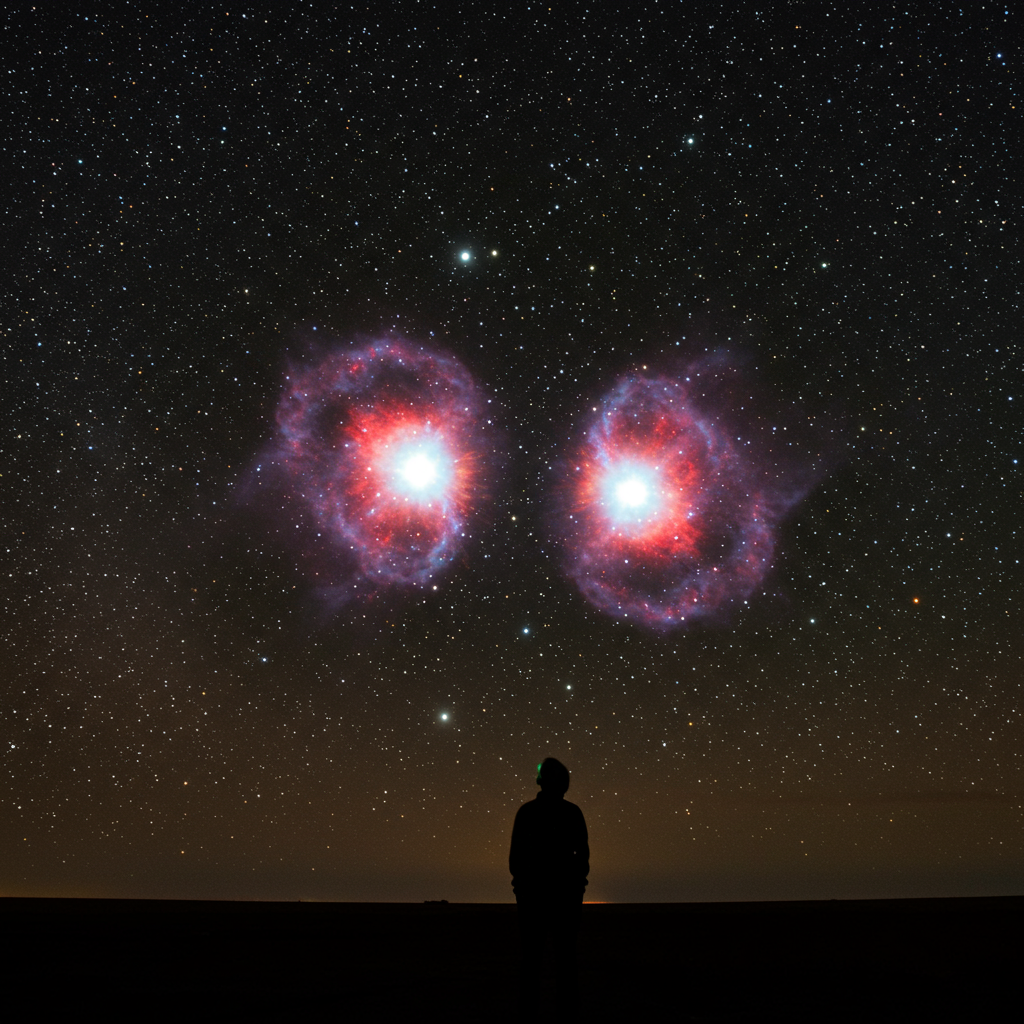The night sky is currently offering a celestial spectacle rarely seen: two “new stars,” or novae, are now visible simultaneously to the unaided eye from Earth’s Southern hemisphere. This is an exceptionally rare astronomical event, providing stargazers with a unique opportunity to witness stellar fireworks without optical aid.
A Second Star Ignites: Nova V572 Velorum
Just weeks after a nova burst into view in the constellation Lupus, another has appeared. This second luminous newcomer is designated V572 Velorum, located within the southern constellation Vela, The Sails. V572 Velorum was first spotted by observers John Seach and Andrew Pearce on June 25, 2025.
Upon discovery, V572 Velorum shone at magnitude +5.7. While faint, this brightness is within the typical limit for naked-eye visibility under dark skies. Excitingly, recent observations show it has brightened slightly to magnitude +5.5, making it an even better target for visual observers.
The First Companion: Nova V462 Lupi
The appearance of V572 Velorum follows the earlier eruption of V462 Lupi in the constellation Lupus, The Wolf, which was detected by the ASAS-SN survey on June 12, 2025. Initially much fainter, V462 Lupi underwent a dramatic brightening. While its magnitude can fluctuate, it is currently reported to be around +5.9, placing it just within the range for naked-eye viewing from a dark location.
This first nova, V462 Lupi, is visible from a wider range of Earth’s latitudes, including mid-to-lower Northern Hemisphere locations. However, the newly appeared V572 Velorum is best seen exclusively from the Southern Hemisphere. For stargazers located south of the equator, this means the extraordinary chance to see both novae in the same night!
Witnessing a Double Nova: How Rare is This?
Seeing even one nova visible to the unaided eye is considered a special event for most observers. The simultaneous visibility of two is truly remarkable. Astronomer Stephen James O’Meara, who has observed both recent novae, has researched historical records to find comparable events.
He notes that a similar instance occurred about seven years ago, in 2018. On March 22, 2018, two Southern Hemisphere novae, FM Circini (Nova Circinis 2018) and V906 Carinae, peaked near identical naked-eye magnitudes (+5.8 and +5.9, respectively). This historical parallel underscores just how infrequent it is for two novae to be bright enough to be seen without a telescope at the same time, particularly from the same hemisphere.
This current alignment, with V572 Velorum in Vela and V462 Lupi in Lupus both gracing the Southern Hemisphere sky, presents a fleeting astronomical treat.
Locating the Celestial Visitors
Finding these temporary stars requires knowing where to look. V572 Velorum is located within the constellation Vela. V462 Lupi is in Lupus. Experienced observers recommend using star charts or astronomy apps that are updated with transient events like novae. The precise location for V462 Lupi is near coordinates RA 15h 09m 42s, Dec -40° 14’ 22”. Starting near familiar constellations like Scorpius can help locate Lupus.
For the best chance to spot them with the naked eye, find a location far from city lights with a clear view of the southern horizon. Allow your eyes time to adapt to the darkness. Binoculars will make finding and confirming them significantly easier, even from less-than-perfect locations. Keep in mind that novae are temporary phenomena; their brightness will eventually fade over days or weeks.
The Science Behind the “New Stars”
Despite appearing suddenly like a “new star,” a nova isn’t the birth of a star or the dramatic self-destruction of a massive star (which is a supernova). Instead, a nova is a powerful, but typically non-destructive, explosion that occurs in a specific type of binary star system.
A Binary Star System
Every classical nova involves two stars orbiting closely together. One is a small, incredibly dense stellar remnant called a white dwarf, roughly the size of Earth but containing about the mass of our Sun. Its companion is usually a larger star, often similar in size and mass to our own Sun, or sometimes a red giant.
The white dwarf’s intense gravity acts like a cosmic siphon. Over vast periods, perhaps thousands of years, it pulls material, primarily hydrogen gas, from its companion star. This gas doesn’t fall directly onto the white dwarf. Instead, it forms a swirling disk, known as an accretion disk, around the white dwarf before spiraling down onto its surface.
The Thermonuclear Flash
As the hydrogen gas accumulates on the white dwarf’s super-dense surface, it is compressed and heated to incredible temperatures and pressures. When enough material builds up – reaching a critical mass and density – the hydrogen undergoes a runaway thermonuclear reaction. This is essentially an uncontrolled hydrogen fusion explosion, similar to what powers the Sun, but happening explosively on the white dwarf’s surface.
This thermonuclear blast is incredibly powerful. It can cause the star system to brighten dramatically, sometimes by a factor of a million times or more, over just a few hours or days. From Earth, where the system was previously too faint to be seen, this sudden surge of light appears as a brilliant “new star” seemingly appearing out of nowhere.
Crucially, the white dwarf itself usually survives this explosion. The accumulated gas is ejected into space, creating an expanding shell of material. After the outburst, the white dwarf can begin accumulating material from its companion once again, setting the stage for potential future nova events, though often separated by thousands or tens of thousands of years.
V572 Velorum and V462 Lupi are both examples of this powerful, recurring process playing out in distant binary systems.
Looking Ahead
While these two novae are a rare simultaneous treat, astronomers continue to monitor the skies for other potential transient events. Another much-anticipated nova, the recurrent nova T Coronae Borealis (T CrB), also known as the Blaze Star, is expected to erupt sometime in late 2025. This event, involving a white dwarf and a red giant, occurs roughly every 80 years and is predicted to become visible to the unaided eye from the Northern Hemisphere when it happens. Each nova offers scientists valuable data about binary star evolution and thermonuclear processes.
For now, Southern Hemisphere observers have a unique opportunity to witness two of these fascinating cosmic outbursts. Finding them requires clear skies and dark locations, but the reward is a glimpse into the dynamic processes occurring far beyond our solar system.
Frequently Asked Questions
What exactly is a nova, and why are two currently visible?
A nova is a powerful thermonuclear explosion on the surface of a white dwarf star in a binary system. The white dwarf pulls hydrogen gas from its companion star. When enough gas builds up, it ignites explosively, causing the system to brighten dramatically and appear as a “new star.” These two specific novae, V572 Velorum and V462 Lupi, recently accumulated enough material to trigger these explosions, becoming bright enough (+5.5 and ~+5.9 magnitude respectively) to be seen with the unaided eye under dark conditions.
Where in the sky can I look to see these two novae?
Both novae are currently best visible from Earth’s Southern Hemisphere. V572 Velorum is located in the constellation Vela, The Sails. V462 Lupi is in the constellation Lupus, The Wolf, near RA 15h 09m 42s, Dec -40° 14’ 22”. You will need a clear view of the southern sky away from light pollution. Using a current star chart, astronomy app, or binoculars can greatly help you pinpoint their locations within these constellations.
How rare is it to see two novae visible to the naked eye at the same time?
It is extremely rare. Seeing even one nova bright enough for naked-eye viewing is uncommon for most observers. Historical records show very few instances where two separate novae have simultaneously reached magnitudes bright enough to be visible without optical aid, particularly in the same hemisphere. Astronomer Stephen James O’Meara found only one recent comparable event about seven years ago, involving two different novae in the Southern Hemisphere.
Conclusion
The simultaneous naked-eye visibility of V572 Velorum in Vela and V462 Lupi in Lupus is a truly exceptional event for skywatchers. If you are in the Southern Hemisphere, take advantage of this rare astronomical opportunity. Find a dark sky location, locate the constellations Vela and Lupus, and look for these temporary visitors. Witnessing two “new stars” blaze in the night sky is a powerful reminder of the dynamic and often surprising nature of the universe.




